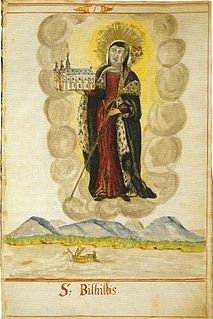Related Research Articles

Year 1167 (MCLXVII) was a common year starting on Sunday of the Julian calendar.

Maaseik is a city and municipality in the Belgian province of Limburg. Both in size and in population, it is the 8th largest municipality in Limburg. The town is the seat of the administrative arrondissement of Maaseik (kieskanton). Internationally, Maaseik is known as the assumed birthplace of the famous Flemish painters Jan and Hubert van Eyck.

William IV reigned as the Grand Duke of Luxembourg from 17 November 1905 until his death. He succeeded his father, Adolphe.

Saint Herlindis, sister of Saint Relindis, was a Frankish saint and abbess.

Saint Relindis, sister of Saint Herlindis, was the daughter of count Adelard who built a Benedictine monastery at Maaseik for his daughters. Herlindis was abbess of the abbey until her death, after which Relindis was named to succeed her by Saint Boniface.

Mont Sainte-Odile Abbey, also known as Hohenburg Abbey, is a nunnery, situated on Mont Sainte-Odile, one of the most famous peaks of the Vosges mountain range in the French region of Alsace.

Herrad of Landsberg was a 12th-century Alsatian nun and abbess of Hohenburg Abbey in the Vosges mountains. She was known as the author of the pictorial encyclopedia Hortus deliciarum.
Gundelina, abbess, she was the third daughter of Duke Adalbert of Alsace and his first wife Gerlinda. She was the younger sister to saints Attala and Eugenia, both nuns and abbesses, and they were all nieces to the famous blind Saint Odilia, the abbess of Hohenburg.

Adalrich, also known as Eticho, was the Duke of Alsace, the founder of the family of the Etichonids and of the Habsburg, and an important and influential figure in the power politic of late-seventh-century Austrasia.
Adalbert was the Duke of Alsace beginning after 683 and probably until his death. He was the second duke of the family of the Etichonids and the first to inherit the duchy from his father.

Quedlinburg Abbey was a house of secular canonesses (Frauenstift) in Quedlinburg in what is now Saxony-Anhalt, Germany. It was founded in 936 on the initiative of Saint Mathilda, the widow of the East Frankish King Henry the Fowler, as his memorial. For many centuries it and its abbesses enjoyed great prestige and influence.

Gandersheim Abbey is a former house of secular canonesses (Frauenstift) in the present town of Bad Gandersheim in Lower Saxony, Germany. It was founded in 852 by Duke Liudolf of Saxony, progenitor of the Liudolfing or Ottonian dynasty, whose rich endowments ensured its stability and prosperity.

Herford Abbey was the oldest women's religious house in the Duchy of Saxony. It was founded as a house of secular canonesses in 789, initially in Müdehorst by a nobleman called Waltger, who moved it in about 800 onto the lands of his estate Herivurth which stood at the crossing of a number of important roads and fords over the Aa and the Werre. The present city of Herford grew up on this site around the abbey.

Hedwig of Saxony was Princess-Abbess of Quedlinburg from 1458 until her death.
Philipp II of Hanau-Lichtenberg ruled the County of Hanau-Lichtenberg from 1480 until his death.

Aldeneik Abbey is a former Benedictine abbey in Aldeneik, currently a mainly residential parish of Maaseik, in the province of Limburg in eastern Belgium. It was founded in 728. The Benedictine nuns were replaced by canons in the 10th century. In the 16th century the canons moved to nearby Maaseik, and Aldeneik was abandoned.

Bilihildis was a Frankish noblewoman, remembered as the founder and abbess of the monastery of Altmünster near Mainz, and venerated locally as a saint, on Nov. 27.
The Abbey of St. John, Laon was a Benedictine monastery in Laon, France, from 1128 to 1766, which replaced a nunnery founded in 641. The prefecture of the department of Aisne now occupies the site.

Richard Puller von Hohenburg was a 15th-century Alsatian and Swiss nobleman and knight. He is notable for his homosexual liaisons, his strategic avoidance of prosecution, and later execution for his homosexuality.
The Vilich Abbey is a former monastery located in North Rhine-Westphalia. It is named after the canonized Adelaide of Vilich, who lived from 970 to 1015. After her death, a cult formed around her and the convent. The convent was terminated in 1804 due to secularization. It was destroyed during the Thirty Years´ war and rebuilt. The Franciscans took over the abbey as a hospital in 1865, followed by many different charitable institutions. The church was destroyed in World War II and once again restored, and is now used as a retirement home.
References
- Wiegand, Wilhelm, "Relindis" in: Allgemeine Deutsche Biographie 28 (1889), p. 186.